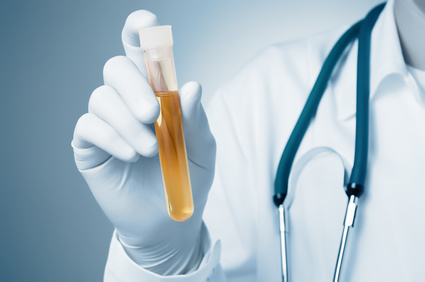1. What are the components of semen?
The semen consists of secretions contributed by testes, seminal vesicles, prostate and bulbourethral glands
| Testes | spermatozoa | Stored in epididymis until ejaculation | 5% |
| Seminal vesicles | Seminal fluid | Contains fructose needed for energy for motility | 60-70% |
| Prostate | Prostatic fluid | Acidic, containing acid Phosphatase, citric acid , zinc and other enzymes
Needed for liquefaction of the semen after ejaculation |
20-30% |
| Bulbourethral glands | Alkaline mucus | Helps in neutralizing the acidity in the vagina | 5% |
2. What are the indications for semen analysis?
The indication for semen analysis are
a. As a part of evaluation of infertility
b. Paternity testing
c. Selection of donors for artificial insemination
d. Evaluation of effectiveness of vasectomy
e. Examination in medicolegal cases as in the cases of alleged rape or sexual assault.
a. As a part of evaluation of infertility
b. Paternity testing
c. Selection of donors for artificial insemination
d. Evaluation of effectiveness of vasectomy
e. Examination in medicolegal cases as in the cases of alleged rape or sexual assault.
3. What are the normal values in semen analysis?
The normal values in semen analysis according to WHO 2010 criteria ( WHO laboratory manual for the examination and processing of human semen .5th ed. Switzerland. World Health Organization 2010.)
| Parameter | Lower reference limit |
| Semen volume (ml) | 1.5 (1.4–1.7) |
| Total sperm number (10⁶ per ejaculate) | 39 (33–46) |
| Sperm concentration (10⁶ per ml) | 15 (12–16) |
| Total motility (PR + NP, %) | 40 (38–42) |
| Progressive motility (PR, %) | 32 (31–34) |
| Vitality (live spermatozoa, %) | 58 (55–63) |
| Sperm morphology (normal forms, %) | 4 (3.0–4.0) |
4. Write a note on semen sample collection?
The following steps have to be followed
a. Ideally the sample has to be collected in a private room near the laboratory. If this is psychologically unacceptable, then the person is instructed to collect at home and should be brought immediately to the laboratory ( within 30 minutes)
b. Collection has to be done after the abstinence period of 2-5 days.
c. Semen obtained by masturbation and has to be ejaculated in a clean wide mouthed container
d. The sample has to be collected whole. The person should be instructed to report if there is any loss of sample during collection
e. The specimen if collected has to be kept at ambient temperature. If it is collected at home, it is best to keep the container in the pockets so that it is kept at near body temperature.
a. Ideally the sample has to be collected in a private room near the laboratory. If this is psychologically unacceptable, then the person is instructed to collect at home and should be brought immediately to the laboratory ( within 30 minutes)
b. Collection has to be done after the abstinence period of 2-5 days.
c. Semen obtained by masturbation and has to be ejaculated in a clean wide mouthed container
d. The sample has to be collected whole. The person should be instructed to report if there is any loss of sample during collection
e. The specimen if collected has to be kept at ambient temperature. If it is collected at home, it is best to keep the container in the pockets so that it is kept at near body temperature.
5. Can the semen be collected in the condoms?
Yes it can be collected only when the person is unable to masturbate. It is collected in a condom during sexual intercourse. latex condoms should not be used as they contain agents that interferes with motility. Nontoxic condoms which are designed for collection should be used. After ejaculation, the condom should be closed and sent in the container to the laboratory.
6. Why is coitus interruptus not a reliable means to collect the semen?
The reasons are
a. First portion of the ejaculate may be lost
b. Bacterial contamination of the sample can occur
c. Vaginal acidic fluid can affect motility.
a. First portion of the ejaculate may be lost
b. Bacterial contamination of the sample can occur
c. Vaginal acidic fluid can affect motility.
7. What are the components of macroscopic examination of semen?
The components are
a. Liquefaction time
b. Viscocity
c. Volume
d. pH
a. Liquefaction time
b. Viscocity
c. Volume
d. pH
8. How is liquefaction identified?
The liquefaction will be complete in 15-60 minutes. Semen immediately after ejaculation will be in the form of thick coagulated mass which will be transformed into homogeneous and watery fluid.
9. What is the cause for delayed liquefaction?
The diseases of prostate like chronic prostatitis where there in inadequate production of prostatic fluid/deficiency in prostatic enzymes results in semen showing delayed liquefaction.
10. How do you assess viscosity of the semen?
After liquefaction the semen is drawn in a pipette and it is allowed to drop . Normal semen leaves in small discrete drops. If the length of the thread formed is more than 2 cm, then it is abnormal
11. What are the components of initial microscopic examination?
a. Observing mucus strand formation
b. Sperm aggregation
c. Sperm agglutination
d. Assessment of motility
e. To look for the presence of other cells like epithelial cells or leukocytes
b. Sperm aggregation
c. Sperm agglutination
d. Assessment of motility
e. To look for the presence of other cells like epithelial cells or leukocytes
12. How to assess sperm vitality?
The sperm vitality is assessed by assessing the integrity of the cell membrane. One of the important method is DYE EXCLUSION METHOD. The dye used is Eosin & Nigrosin solution. This is a stain which does not permeate the cell membranes.
The principle here is very simple. The dead cells or the non vital cells have damaged cell membranes, so they allow this stain to permeate the membrane ( vital cells do not allow) . So the dead spermatozoa takes stain and stains red or dark pink.
The same test can be done by using eosin alone. But this cannot be stored for quality control purposes.
The principle here is very simple. The dead cells or the non vital cells have damaged cell membranes, so they allow this stain to permeate the membrane ( vital cells do not allow) . So the dead spermatozoa takes stain and stains red or dark pink.
The same test can be done by using eosin alone. But this cannot be stored for quality control purposes.
13. What is the name of the counting chamber used to count spermatozoa?
a. Improved Neubauer chamber- commonly used
b. Makler chamber: commonly used in andrology laboratories.
c. MTG counting chamber.
b. Makler chamber: commonly used in andrology laboratories.
c. MTG counting chamber.
14. How do you determine the sperm morphology?
The spermatozoa morphology is determined after examination of the stained smear of the semen. Stains like Papanicolaou, Shorr or DiffQuik stain can be used.
15. What are the features of a Normal Spermatazoa?
The shead should be oval , regular and smooth
b. There should be a well defined acrosomal region which should be 40 – 70 % of the head.
c. The mid piece should be slender, regular and should be the same length as the head
d. The tail should be thinner than the mid piece and should be around 10 times the head length
b. There should be a well defined acrosomal region which should be 40 – 70 % of the head.
c. The mid piece should be slender, regular and should be the same length as the head
d. The tail should be thinner than the mid piece and should be around 10 times the head length
16. What are the abnormal forms of human spermatozoa?
These are as follows
a. Head defects: tapered, round, amorphous, vacuolated
b. Mid piece defect: assymetrical, thin
c. Tail defects: too short, coiled, bent.
a. Head defects: tapered, round, amorphous, vacuolated
b. Mid piece defect: assymetrical, thin
c. Tail defects: too short, coiled, bent.
17. What is the importance of seminal fluid fructose?
Low levels of fructose indicate decrease in seminal fluid concentration and thereby low sperm concentration. The fructose levels are estimated by spectrophotometric methods and should be done within 2 hours. Less than 13 micromol per ejaculate is abnormal.
18. What is the significance of increased leukocytes in semen?
Presence of more than 1 million leukocytes per ml indicates infection with in the reproductive system.
19. What are sperm function tests?
They are more sophisticated tests done to determine functional ability. The common ones include
a. Hamster egg penetration- here the spermatozoa are incubated with hamster eggs. They are observed microscopically to look for penetrating ability.
b. Penetration of cervical mucus: The partners mid cycle cervical mucus is collected. The sperm is incubated with this mucus and then observed under microscope for its ability to penetrate.
a. Hamster egg penetration- here the spermatozoa are incubated with hamster eggs. They are observed microscopically to look for penetrating ability.
b. Penetration of cervical mucus: The partners mid cycle cervical mucus is collected. The sperm is incubated with this mucus and then observed under microscope for its ability to penetrate.
20. What is Aspermia?
Aspermia is absence of semen on ejaculation. The most important cause is retrograde ejaculation. Retrograde ejaculation means, instead of semen ejaculated out via urethra, it is redirected to urinary blader.
21. What is Azoospermia?
Azoospermia is no spermatozoa in the ejaculate. This can be due to suppression of spermatogenesis. If the spermatogenesis is normal, then it can be due to obstruction of the genital tract distal to the testis.
22. What is Oligozoospermia?
It is diagnosed when the total number or concentration of spermatozoa below the lower reference limit.
23. What is Hemospermia and Leukosepemia.?
Presence of erythrocytes in the ejaculate is called Hemospermia or Heamatospermia. Presence of leukocytes in the ejaculate above the threshold value is called as Leukpspermia. It is also called as Leukocytospermia or Pyospermia.
24. What is Asthenozoospermia?
It is diagnosed when the percentage of progressively motile (PR) spermatozoa below the lower reference limit ie, less than 32%.
25. What is Teratozoospermia?
It is diagnosed when the percentage of morphologically normal spermatozoa below the lower reference limit.











Recent Comments